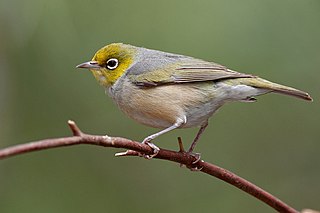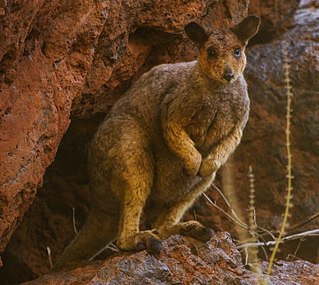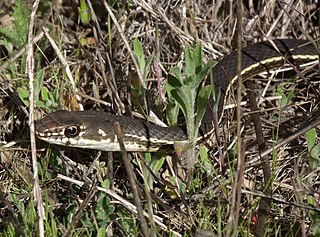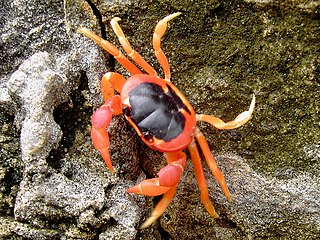
Intramuscular injection, often abbreviated IM, is the injection of a substance directly into muscle. In medicine, it is one of several alternative methods for the administration of medications. Muscles have larger and more numerous blood vessels than subcutaneous tissue and injections here usually have faster rates of absorption than subcutaneous injections or intradermal injections. Depending on the injection site, an administration is limited to between 2 and 5 milliliters of fluid.

The silvereye or wax-eye is a very small omnivorous passerine bird of the south-west pacific. In Australia and New Zealand its common name is sometimes white-eye, but this name is more commonly used to refer to all members of the genus Zosterops, or the entire family Zosteropidae.

The golden-mantled ground squirrel is a ground squirrel native to western North America. It is distributed in British Columbia and Alberta through the western United States to California, Arizona, and New Mexico.

The quadriceps femoris is a large muscle group that includes the four prevailing muscles on the front of the thigh.

The Rectus capitis lateralis, a short, flat muscle, arises from the upper surface of the transverse process of the atlas, and is inserted into the under surface of the jugular process of the occipital bone.

The vastus lateralis, also called the ''vastus externus'' is the largest and most powerful part of the quadriceps femoris, a muscle in the thigh. Together with other muscles of the quadriceps group, it serves to extend the knee joint, moving the lower leg forward. It arises from a series of flat, broad tendons attached to the femur, and attaches to the outer border of the patella. It ultimately joins with the other muscles that make up the quadriceps in the quadriceps tendon, which travels over the knee to connect to the tibia. The vastus lateralis is the recommended site for intramuscular injection in infants less than 7 months old and those unable to walk, with loss of muscular tone.

Masticophis is a genus of colubrid snakes, commonly referred to as whip snakes or coachwhips, which are endemic to the Americas. They are characterized by having a long, thin body and are not dangerous to humans.

The lateral circumflex femoral artery is an artery in the upper thigh.

The black-flanked rock-wallaby, also known as the black-footed rock-wallaby or warru, is a kind of wallaby, one of several rock-wallabies in the genus Petrogale.

Rothschild's rock-wallaby – Petrogale rothschildi – sometimes known as the Roebourne rock-wallaby, is a species of macropod found in Western Australia, in the Pilbara district and the Dampier Archipelago. It is not currently considered to be threatened, but is at risk from the red fox.

Phytophthora lateralis is a soil-borne plant pathogen that causes cedar root disease in Lawson cypresses in Northern USA. This pathogen was first noted to cause disease in around 1920 on nursery stock near Seattle. Pacific yew is also vulnerable to P. lateralis but less susceptible than Lawson cypress trees, and tree mortality has only been observed in areas where C. lawsoniana trees were also infected. Asiatic species of Chamaecyparis are generally described as resistant to P. lateralis, although this pathogen is occasionally isolated from Chamaecyparis obtusa in nurseries.

The whistling cisticola is a species of bird in the family Cisticolidae. It is found in Angola, Benin, Burundi, Cameroon, Central African Republic, Republic of the Congo, Democratic Republic of the Congo, Ivory Coast, Gabon, Gambia, Ghana, Guinea, Guinea-Bissau, Kenya, Liberia, Mali, Nigeria, Senegal, Sierra Leone, South Sudan, Togo, Uganda, and Zambia. Its natural habitats are subtropical or tropical dry forests, dry savanna, and moist savanna.

The California whipsnake, also known as the striped racer, is a colubrid snake found in habitats of the coast, desert, and foothills of California.

Gecarcinus lateralis, also known by the common names blackback land crab, Bermuda land crab, red land crab and moon crab, is a colourful crab from the family Gecarcinidae.
Mulinia lateralis, the dwarf surf clam or coot clam, is a species of small saltwater clam, a bivalve mollusc in the family Mactridae. It occurs in the western Atlantic Ocean and the Caribbean Sea.

Furcifer lateralis, also known as the carpet chameleon or the white-lined chameleon, is a species of chameleon that is endemic to Madagascar. It was described in 1831 by John Edward Gray.

Sybra is a genus of beetles in the family Cerambycidae, containing the following species:

Sybra umbratica is a species of beetle in the family Cerambycidae. It was described by Pascoe in 1865.

Sybra ordinata is a species of beetle in the family Cerambycidae. It was described by Bates in 1873.
Saperda lateralis is a species of beetle in the family Cerambycidae. It was described by Johan Christian Fabricius in 1775. It is known from Canada and the United States.



















